...Kathmandu was never built, it just grew up like weeds. That is why the city takes the knowledgeable tourist perpetually by surprise. He can never tell what next he may bump into after drifting along for a five-minute distance from a golden pagoda. The old city abounds in the deposits of time, groaning buildings with beautifully carved but rotting verandas, temples and pagodas in disrepair, cracking doorframes with exquisite details, places of worship with obscene terracotta. It is the art in ruins and disarray, the islands of symmetry in the thick of fuming slums and green gutters, the harmony in bronze and stone thick with pious scum that unnerve every outsider in Kathmandu. Amidst such a mighty confusion of holy cows and mangy dogs, elusive men and markets, suffocating traffic and pedestrians, stubborn street vendors and obscure holes, suddenly there is an island of calm and order, repose and harmony, the work of an unknown artist or artists who betrayed their disdain everywhere in stone, wood and metals. -Kamal P. Malla
 Silver Craft
Silver Craft
The origin of silver dates back to the pre- historical era, shortly after the discovery of copper and gold. The Egyptians considered gold to be a perfect metal and gave it the symbol of a circle. Since silver was the closest to gold in perfection, it was given the symbol of a semi-circle. Later, this semi-circle led to a glowing moon symbol, probably because of the similarity between the shining metal and the glowing moon. The ancient people considered silver a sacred metal just like gold. It was also used for paying debts, in personal and religious places, decorations and in utensils of the wealthy. Its malleability and ductility makes silver
ideal for making ornaments. The young and fashionable generations prefer silver jewelry, because of its affordable prices. These days, silver jewelry inlaid with various precious and semi- precious stones are all the rage. Silver found in the Nepali market usually contains 95% pure silver. The raw materials are imported from countries like Switzerland and Australia besides Hong Kong.
 Swoyambhu Ratna Tuladhar
Swoyambhu Ratna Tuladhar
Swoyambhu Ratna Tuladhar is the proprietor of Yak and Yeti Enterprises Pvt. Ltd., established in 1983. It is one of Nepal's leading exporters and manufacturers of distinctive sterling silver jewelry with more than 10,000 exclusive designs.
How did you get into the trade?
When I started in this trade, my original purpose was to provide a means of support for the artisans of the Kathmandu Valley. I also wanted to exhibit Nepali craftsmanship all around the world.
How is your business doing today?
Good. Y&Y has been supplying jewelry to the USA, Hong Kong and China. Till date, it has been financially supporting over 150 artisan families who supply us with their goods.
What is your specialty?
Our uniqueness lies in the artistic handcrafted designs that reflect Nepali and Tibetan ethnicity. We constantly try to create innovative and attractive designs catering to the international market.
For details: 4428599 / 4413552
 Yagya Narayan Gupta
Yagya Narayan Gupta
Yagya Narayan Gupta established Amrita Crafts in 1985 with a small shop. Today, it has expanded into a big showroom in Thamel. Besides many other handicraft items, Amrita specializes in different silver products.
How did you get into the trade?
This handicraft had always fascinated me. I knew that it could capture a vast market if pursued with a vision. So, I joined the trade by selling products made by the local artisans.
You cater to both tourists and the international market. What are the differences in their tastes?
The tourists mostly want ethnic silver products and those that symbolize Nepal, like religious statues, Buddhist pendants, etc. They want something to remind them of Nepal. But the international market follows the latest fashion trends. We need to constantly update ourselves with the latest international tastes.
In the international market, what is Nepal's specialty?
Most countries have adopted machines to make jewelry but Nepali products are still hand-made. Therefore, our handicrafts are exquisite and unique.
For details: 98510-47286
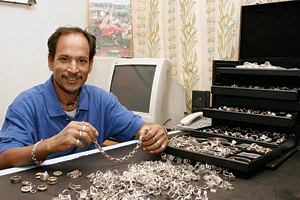 Suman Dhakwa (Craftsman)
Suman Dhakwa (Craftsman)
Suman Dhakwa has created his own brand of jewelry, which stand up to the high standards of the international jewelry market. His creations are sold alongside top brands like Gucci and Cartier. A skilled craftsman, he also runs a silver business that goes by the name ‘Valhalla’. Each of his products has the name ‘Suman’ inscribed on it. “My family profession is actually statue-making. I always wanted to do something different and became involved in silver handicrafts,” Suman elaborates.
Every month, in Japan, around 3-4 wedding rings manufactured by Suman are sold. Along with Suman’s name, the couple’s names and the wedding date are also inscribed on it. “They tell me that my name gives them inspiration which is the biggest compliment I’ve received so far,” says Suman. Besides rings, designer products like brooches, other products like lighters, necklaces, pens, mobile handles, cigar cases, earrings, etc. are also popular.
“The most important misunderstanding among Nepalis is the notion that products bought by tourists here are equally in demand in the international market. This is completely wrong. Also, while exporting a product, we should be able to fully guarantee them and replace defective goods as I have been doing so far,” Suman marks.
For details: 5537081
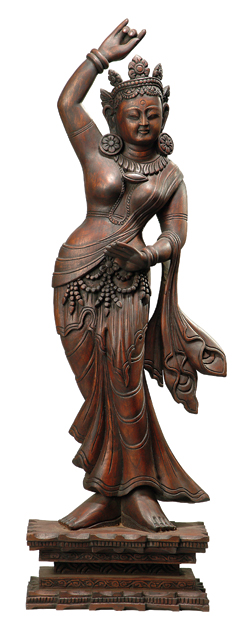 Woodcraft
Woodcraft
Furniture boutiques are abundant around Kathmandu valley, displaying anything from antique Tibetan furniture to elaborately designed and carved idols and decorative items in wood. But if one visits Bhaktapur and witnesses the Peacock window at the Dattatreya Square, the sheer beauty of the ancient handiwork carved by traditional woodcarvers of a bygone era, will amaze him. At the Woodcarving Museum, works of art like the superb 16th Cent. statue of Manjushree and a three- foot tall statue of Bhairav, the 15th Cent. statue of the dancing Goddess Nartaki Devi, life-size woodcarving of Jagannath and his brother Balaram or Balabhadra can be seen. However, it is the courtyard windows, pillars and cornices that are remarkable examples of the skill of our woodcarvers that grab your attention immediately. These images surpass all others in the world of woodcarving in Nepal.
Nepal is a treasure trove of woodcarving though the rich traditional knowledge of Nepali art and architecture in wood is fast disappearing due to urbanization and modernization in architecture. But whatever has survived until now is amazingly rich in decoration and symbolism. The modern artisans have preserved to this day the traditional techniques handed down to them by their ancestors. And of the four hubs of handicraft-- Kathmandu, Patan, Bhaktapur and Bungmati, the
artisans from the latter excel and are to be revered.
 Kiran Kumar Sthapit
Kiran Kumar Sthapit
Adopting the family commerce and trade, Kiran is the proprietor of Purna Wood Carving Industries in Patan, established in 1978. Purna B. Sthapit and Purna Sthapit, grand-father and father respectively, were ivory carvers and carpenters and Kiran learnt the craft from them at home not only because it was a family trade, but because their forefathers were architects of the golden era.
How is the market of woodcraft?
Handicraft with its values and norms is popular amongst international buyers. When there is a big demand, we cannot meet the requirements. Due support from concerned authorities is not provided sufficiently and we have not been able to achieve much. Wood handicraft has unlimited potential and whatever has been done is because of our perseverance in the trade.
What problems do you face concerning export?
Firstly, the archaeology department should shift to the outskirts near ring-road areas where we can transport our bulky crafts to be identified and stamped for export. It was a big problem transporting a huge 18ft. gate that was to be flown to Bahrain to the archaeology department in the capital. We have held several top-level seminars concerning the subject but things have not worked out. The concerned authorities also have to support us in finding greener pastures for our products.
What specifically are your popular products?
Statues are always in demand but at present, we are trying to promote Newari architecture in a commercial way. For example, we make 'Patis' or resting places that can be constructed in one's garden. It is popular amongst home-makers. Wooden gates, doors and windows are always in demand and we also decorate living rooms in authentic Newari handicrafts. Concerning the external market, we specialize in out-door temples of wood. We built a huge wooden temple in Singapore in 2001. It is 85 ft. tall and has been placed at the Gorkha Contingent. We even provided bricks from here. We have also constructed wooden windows at residences for the people of Honolulu. Clients have increased not only abroad but domestically as well, though it is a bit more expensive for the latter.
Are the people in this trade environment conscious?
We are conscious of the environment though we do not have any support. We have planted trees at Hetauda and I believe that if we cut one tree, we need to plant 100 more.
Any major projects in wood that you want to share with us?
We constructed a replica of a temple for Hotel Yak & Yeti at Walt Disney Island in Florida and most of the woodwork at the Hyatt Regency.
For details: 98510-27260
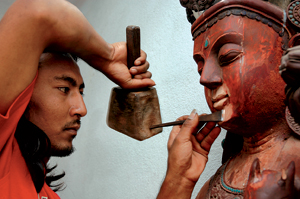 Sri Tuladhar (Craftsman)
Sri Tuladhar (Craftsman)
Sri Tuladhar was born in Bungmati, the hub of carpentry in Nepal. Working at his small workshop at Lachhi Cha, Tuladhar explained that he developed his skills by himself though he underwent a designing course organized by HAN and started as an artisan from 2000. Sri specializes in ‘Krodh Murti’ or Wrath Idols, which with its intricate details makes it a prized possession and an awesome spectacle. “Wood carving is a sensitive craft because we do not have a dummy or a frame like those used in preparing metal idols. We have to work from scratch with minimum corrections. There is no room for error,” explains Sri.
He explained that the craft of shaping wood into masterpieces is disappearing at an alarming rate and needs to be documented and that artisans should be exposed and promoted. Though the craft dates back to the Lichhavi era, the golden era of craftsmanship, the art is not imitated perfectly. “It is because of the need to survive in this world of cut-throat business. Craftsmen have to sell their creations anyhow to create another, which is not of quality because minimum time and labor is spent in the effort,” he elaborates.
Sri toils 10 to 12 hours everyday shaping wood into original creations and that is how his craft is evaluated. “I love this profession and want to take it to a higher level; that of art, though it is difficult. It is tough to follow the rules of the craft, especially when working with Krodh Murtis, but I hope to teach interested youngsters the art one day,” concludes Sri. For details: 2210058 / 9803151578
 Bamboo
Bamboo
Bamboo has been used extensively in the Nepali households since time immemorial - more so in rural Nepal than in urban settlements. Nanglo, a flat, circular shaped bamboo tray for winnowing grain finds common usage and equally familiar are the bamboo dokos (baskets) used by porters to transport goods. Bamboo has been put to good use in households around the country. But nobody uses bamboo like the Kirantis (Rais and Limbus) of eastern Nepal, who once even kept letters in bamboo cases.
However, bamboo handicrafts are a relatively new development in the form of different decorative
objects like lamps, miniature houses, pen stands, etc. Many of them are still made in the east and find a market here in Kathmandu. Miniatures make fine decorative pieces while bamboo handcrafted furniture is gradually making inroads into the furniture market in the valley.
The traders usually purchase bamboo in bulk from valleys outside Kathmandu. The green and young bamboo is used for weaving while the dried ones are cut and created into different products. Nepali bamboo handicrafts are being exported very cheaply.
 Gokul Rai (Craftsman)
Gokul Rai (Craftsman)
Gokul Rai is a man of many talents. A skilled bamboo craftsman, he is also a musician, singer and artist. He grew up in Jhapa where bamboo was found in abundance, but not many knew that bamboo handicrafts could be wonderful works of art. Being an art lover, he was always interested in creating new things. One day, he got hold of some bamboo and started making boxes of various designs. “Many appreciated my work and I started making decorative bamboo gramophones, flower vases and ashtrays to begin with.” Rai reminisces.
While creating designs, Rai experiments a lot. He listens to classical music for inspiration and comes up with designs like his double purpose coin box in the shape of a house, which can be used for decoration as well as for collecting money. “I make bamboo mirrors, Japanese fans, wall- clocks, bamboo frames and newspaper racks,” says Rai. He is not only involved in craft making, but also regularly trains people from different parts of Nepal. “I have even trained some blind people of Banepa (outside Kathmandu valley) to make bamboo handicrafts and they are still engaged in the craft with the help of a guide,” adds Rai. For details: 5530193
 Rohini Rana
Rohini Rana
Rohini Rana is the proprietor of Miracle Bamboo Craft, a growing enterprise that has outlets all over the city. She shares her experiences in the trade.
How did you get into this business?
One day, I visited a handicraft exhibition at the Hotel Blue Star. There, I saw many stalls with different handcrafted items. Since I often made different metal handicrafts as a hobby and people appreciated my work, I thought of putting up my own stall. Six months later, Nepal Handicrafts Association organized an exhibition in which I participated. Along with my metal handicrafts and oil paintings, I purchased some bamboo handicrafts from my friend's shop and put them up in my stall. The bamboo handicrafts sold instantly and people even placed orders for more. Hence, I decided to make such handicrafts myself by purchasing a bamboo vase. I studied the making process by looking at it innumerable times. I later broke it and experimented with new designs. I then purchased some bamboo and started creating different handicrafts.
Were there any initial struggles?
Yes. Although my family and friends appreciated my skills, they did not encourage me to get into the trade. People thought that this craft was only meant for lower caste people and looked upon it in disdain. However, I took it as a challenge and made it my career.
How is your business doing today?
We have around twenty in our staff involved in making bamboo handicrafts. Besides, we also give regular training and provide job opportunities to rural social victims in collaboration with NGOs, Sahara Group and UCEP (Underprivileged Children Educational Program) Nepal. We have outlets in Lazimpat, Dhalku and Bhotahiti, catering mostly to the local market.
For details: 98030-17960
Ceramics
Ceramic handicrafts can be defined as a modern form of traditional clay handicrafts. The glazing and coloring process distinguishes ceramic handicrafts from traditional ones. If the history of traditional clay handicrafts is buried in antiquity, ceramic handicraft is only two decades old in Nepal. Mostly manufactured in Bhaktapur and Thimi, ceramic handicrafts took the form of a sustainable business about seven years ago.
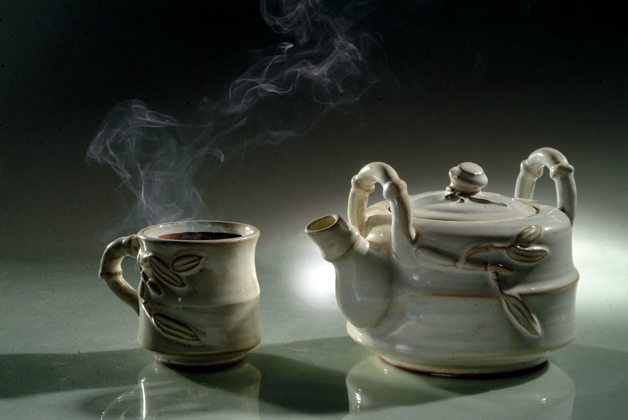
Till date, craftsmen in Nepal have only focused on making earthenware ceramics with ceramic colors like white, blue, gray and light green. The filtered plastic clay is usually brought in bulk from valleys like Dang in western Nepal. They are then given various shapes with the help of spinning wheels and different designs are created. Later, the products are left to dry in the sun and then fired in a downdraft kiln. Finally, the pieces are glazed using different colored chemicals and fired again to give a final glaze.
It has been scientifically proven that food eaten in ceramic plates is good for health and enhances digestion. Ceramic wares are also attractive, elegant and environmentally sound.
 Dan Krishna Prajapati (ACP)
Dan Krishna Prajapati (ACP)
The Cement and Ceramics Industry in Sanothimi, Bhaktapur was established in 1999. It is fully based on exporting ceramic handicrafts to different parts of the world. Proprietor Dan Krishna Prajapati talks about the business aspects.
How did you get into the business of ceramic handicrafts?
Making traditional clay handicraft runs in our family. After a basic training from GTZ in 1984, I joined the profession of making ceramic handicrafts.
What specific products are more popular?
In the international market, kitchenware like tea sets and plates, vases, plate holders and jars are very popular.
How is your business doing today?
I have been regularly exporting my handicrafts to different countries like France, Germany, USA and Belgium. They prefer our products because the same products made in these countries are very expensive. Our products are comparatively cheaper and good quality is guaranteed. For e.g. a simple teapot manufactured there costs around US $ 250/- while we export at US $3/-. For details: 6631094 / 6633417
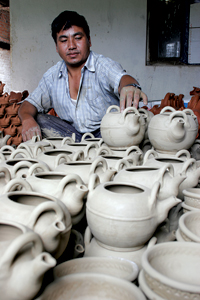 Hari Bahadur Prajapati (Craftsman)
Hari Bahadur Prajapati (Craftsman)
Making clay handicrafts is Hari Bahadur Prajapati’s family profession. Like all other kids in the family, he was initiated into the trade from early childhood. He was later trained by Nepal Handicrafts Association, after which he joined the trade of making ceramic handicrafts. “While creating designs, I keep in mind the customer’s demands and blend it with my own innovations. I love playing with the clay. It’s a fascinating art and I don’t find it difficult since I get totally immersed in the creative process,” says Hari.
While making handicrafts, he mostly uses tools like the spinning wheel, wooden design blocks, horns of animals like sheep, cows, etc for smoothness, down draft kiln, threads and extruder. “Initially, we had no machines, so we had to spin the wheel manually in order to create different shapes and sizes. It was very tedious. Now, with the spinning wheel machine, the task is a lot easier. To attain perfection in this craft, continuity in the work is very important,” explains Hari. For details: 6631094 / 6633417
 Metal Craft
Metal Craft
The first batch of visitors who were brought into the valley by Boris Lissanevitch were
astonished to find incredibly fine works of metal art displayed at the Royal Hotel. The medieval city of Kathmandu was and still is famous for its metal crafts and specimens of exquisite pieces are seen at almost every nook and corner especially at old palace squares and the hundreds of temples and stupas.
The city of Patan is even today the center of metal craft. It thrives with handicrafts of every possible material found around the country. Walking through the alleys of Patan, visitors can train their ears on the sound of small hammers tapping metal using ancient techniques that have not only been preserved but seem to predominate.
As one of the major handicrafts of Nepal, metal crafts are produced totally by hand with traditional techniques like hammering and hand-casting. Through these methods traditional wares like utensils, singing bowls, brass and copper kitchen wares, bells, cymbals, Tibetan metal crafts, Buddha images, khukuris, etc are prepared, which are exquisite and intricate. The artisans require a high level of accuracy, planning and technique, a skill handed down from generation to generation.
 Deepak Ratna Shakya
Deepak Ratna Shakya
Curio Arts; Specialist in Tibetan and Nepali Works of Art, was established at Durbar Marg some 28 years ago and Deepak as its proprietor has adopted the family metal trade as a businessman. Deepak shares his views on metal handicraft in Nepal.
How is metal craft as a business?
This is an export trade, but due to the political upheaval in the country, the business is at its lowest. Buyers should be in the country to choose their order. That way we can give them quality and a whole lot of options to choose from. But the scenario is different. Today we send letters, e-mails, and also use the postal and courier services to send our catalogues to buyers who are abroad. This way we have lost a substantial number of buyers and I would say 50% of the trade is lost.
How are you coping with the problem at hand?
Though we are promoting our art as a business, we have not received any assistance from concerned authorities, and we cannot carry heavy loads when traveling abroad to give more choices to our clients. We have been taking samples of our products abroad and have been showing them to buyers. But in the long run, sustaining our business this way is impossible.
What do you specialize in?
We specialize in statues, silver decorative pieces and special products. We export them to the U.S., Germany, Italy and Japan.
What are the drawbacks in this trade?
We place our clients' orders to artisans who create the handicraft. Sometimes when we place a big order with the artisans, they ironically raise the price. Our buyers do not understand this, but we have to deliver. It then cuts down our profit margin.
For details: 98510-26772
.jpg) Mangal Ratna Shakya (Craftsman)
Mangal Ratna Shakya (Craftsman)
Recognized as one of the most prominent fine face carvers in the community of artisans, Mangal Ratna Shakya was born in Patan. Mangal’s career started at the age of 15 when his father taught him the skills. He specializes in ‘Shanti Murti’ otherwise known as ‘Peace Statues’. His sons Rustam and Rupesh have also adopted the trade. Mangal explains that ‘Mukha Kriti’ or face carving is perhaps the most demanding in the process of crafting a statue.
Mangal used to toil for at least 8 hours a day in his prime but at present works only for two to three hours a day due to his age. The demand for his expertise grows day by day. “My creations are not available in the market but people identify them from afar. I make statues in accordance to orders placed by businessmen who sell them to their clients and each idol is unique. There aren’t any replicas unless requested,” explains Mangal.Though he is with a trade that necessitates guarding its secrets, he took the opportunity to impart his expertise to the students of HAN and 75% of the students have excelled in the trade.
Mangal visited Hokkaido, Japan in 1992 where he had the opportunity to share his culture and expertise. During his stay, Mangal completed a 200Kg gold Amoghpasha Lokeshwor statue which was later stolen. He has no regrets, but feels strongly for a Maha Manjushree that he created. “It was taken abroad for an exhibition by a businessman who won a gold medal for its display. All I got was a shirt and a Seiko watch from him. Artisans have to be promoted and recognized, because it is they who toil and create. They are the creators and not the businessmen,” explains Mangal. For details: 5540829
 Lokta
Lokta
Ancient religious manuscripts and sacred texts in Nepal were almost always written on Lokta paper and till date, legal files and government documents as well. This technique of paper-making could attribute its allure to the fact that it results in one of the most durable papers that exist, and one with vast artistic potential. The making of Lokta paper - commonly identified as rice paper or Nepali kaagaz - represents a traditional craft that has been passed down for generations and has existed in these mountainous parts for over a thousand years. Whether due to the inherent strength of lokta fibers and their resistance to insect-attack, or because of its rough, crinkly appeal, it is certain that handmade Nepali paper has been picking up tremendous popularity, particularly in the overseas market. What is interesting is that the industry is environmentally self-sustaining, because the lokta plant regenerates at surprising speed. And since most of the initial manufacturing takes place in villages, it is also a significant source of revenue for the rural workers.
More important, perhaps, is the paper’s aesthetic value, which is what draws people to these hand-crafted products. Designer lampshades, wall-paper, photo albums, frames and even curtains made of Lokta paper can be found. A great many artists in the country are partial to it because it not only ensures them a sturdy, long-term base for their pieces, but also provides beautifully textured surfaces. An ancient art that boasts endless creative possibilities, Lokta paper is here to stay.
Dibya Acharya
It was about 13 years ago that Dibya Acharya established General Paper Industry, with a showroom in Thamel that has on offer a wide range of Lokta paper products. He talks about his experiences in the trade.
How was it that you started out in this business?
I realized that despite their immense talents, craftsmen as well as traders in Nepal were clueless on how to market that skill. I wanted to add a touch of glitz to the products, make them saleable internationally. I set up a small showroom in the city with the objective of presenting Lokta art in a fresh and elegant manner.
Do you believe you've achieved what you intended to?
Yes, I am quite content with the pace of business now. Lokta paper has actually moved up to being one of the top most exportable handicrafts in the country. We've targeted the European market and our products have been well-received. What I personally enjoy is the knowledge that this is a completely 'Nepali' trade, where our own people are employed in the making process, the crafting process and the sharing of profits as well.
What do you feel is lacking in the Lokta paper industry in Nepal?
I always say that it’s the balance between innovation and tradition that will lead the way, and we've managed to do that to an extent. But we still need to achieve diversification - both in terms of product and marketing, and we must emphasize more on the need for quality.
For details: 5543456 / 4700475
 Dibya Tara Tuladhar
Dibya Tara Tuladhar
Dibya Tara Tuladhar is the proprietor of Annapurna Handmade Paper Craft, a small business that was set up about a decade ago. The first in her family to take up this sort of venture, Dibya gives us an idea of what it’s like in the Lokta industry.
What new innovations have you brought into the art of Lokta?
I started out by making pouches, purses and bags. Soon, I tried making Lokta paper clothes as well. Presently, I’m making beads out of the paper and using them in various kinds of jewelry, which hasn’t been attempted before.
How difficult was it setting up the business?
People at home were surprisingly supportive of my decisions and it wasn’t a big change, since I’d be working from my house anyway. The financial aspects took a little getting used to, but I’ve learnt a lot, so all the initial difficulties were completely worth it.
What potential do you see for the Lokta industry in the future?
There are a lot of different techniques that we could apply to bring about variety. The basic sheet itself can be made with various additional materials, such as embedded flowers, leaves, sand or marble to accentuate the textures. We need to be more ambitious, I suppose, and explore new directions. For details: 4254238
 Raju Shrestha (Craftsman)
Raju Shrestha (Craftsman)
A few floors up, overlooking the hustle and bustle of the marketplace in Ason, we find the quarters of Annapurna Handmade Paper Craft, a private establishment specializing in Lokta paper products among other goods. Kavre-born artisan Raju Shrestha has been working in the small workshop for more than six years, and it was a fellow craftsman who instigated him into the art. Though his duties do not include the actual making of Lokta paper, which is mostly obtained in bulk from another manufacturer, the twenty five-year-old is in charge of designing the finished products, in collaboration with his employer, Mrs Dibya Tara Tuladhar.
“She trained me initially,” he remembers, “I didn't know much back then. But gradually, as my interest in the art grew, I created more pieces of my own and have been doing so ever since.” Raju's specialty seems to lie in making exquisite boxes and lampshades in Lokta paper; each individually crafted in accordance with his unique vision and style. Also interesting are the decorative wall hangings that have been fashioned out of waste paper, thereby making a much-needed statement against industrial wastage. “Its important, especially considering the ecology today, to make the wisest use of resources,” he says. It is therefore one of the reasons he chooses to avoid using machines in his work, because he believes the Lokta industry should be true to its roots and remain hand-based as far as possible. For details : 4254238
Stone Carving
The Malla kings went to extremes to possess valuable artistic creations. It is noted
that there always was competition between artisans of Kathmandu, Lalitpur and Bhaktapur and that their wealth of architectural monuments and art collections grew. Fearing someone would make a replica of their prized work, the artisans' hands were cut off.

It is believed that during the reign of King Vrishdeva of the Lichhavi era, a farmer named Balbala created a self-portrait in stone for the first time and gained recognition in the community. His fame spread far and wide. Due to his innovative creations in the new field of art, Balbala became known as the founder of stone sculpting in the country.
Stone creations are found in abundance in the country in the form of stone spouts, water taps, images of lions and griffins around temples and stupas, chaityas, obscure gods that date back centuries and those that are set there by the faithful seeking a connection with the immortal. As there was no alternative, the history of Nepal thus was written in stone but the oral tradition fails to identify the nation's archaic culture. To those who desire to seek its history, stone craft will tell them the clearest stories.
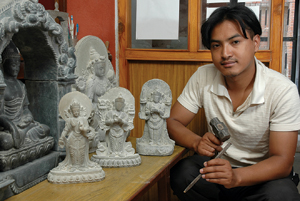 Manoj Shakya (Craftsman)
Manoj Shakya (Craftsman)
Embracing a family trade, Manoj Shakya is the second son of Prem Ratna Shakya, and was born in Patan at Bhimshen Bahal, the center of stone craft. Manoj started sculpting stone around the age of 12 during school holidays on the insistence of his grandfather, late Bekha Jyoti Shakya. His elder and younger brother Amar and Umesh also sculpt Buddhas, chaityas, mandalas, water spouts, decorative items, etc., which meet the demands of businessmen and customers alike.
Manoj trained at Accheshwor Mahabir for two years with sculpture maestro D. B. Lama and traditional pattern expert Raj Kumar Shakya. “Stone quarries have stopped providing us with stone because they themselves have learnt the craft, though their products are not of good quality. Concerned authorities have to look into this matter,” says Manoj. “They also have to look into matters of export as sometimes the cost of its services is more than that of the product itself, due the weight of the craft,” he further added.
Manoj and his family received a letter of commendation from the Rotary Club of Patan in recognition of their good work. As a unit, they have participated in different exhibitions here and abroad. More of their expertise is being sought after they installed the ‘Gazur’ (steeple), at Swoyambhu and four out of the eight chaityas at the Hyatt Regency in Boudha.
“Beware of duplicates,” warns Manoj because there are plenty in the market. They are produced by artificial powder which is melted and shaped according to the original. “There is no difference as every intricate design is replicated but they are not of stone. Perhaps that is why originals are bought personally and not through retailers, besides that ordered by businessmen,” explained Manoj.
For details: 5541498 / 9841-245960
 Lok Raj Bajracharya
Lok Raj Bajracharya
Lok Raj Bajracharya is well known for his expertise in stone handicraft, and is the son of Late Buddha Ratna Bajracharya who was regarded as one of the leading figures in the trade. Lok comes from a family that has been in this trade for the past five generations. He explains that he adopted the business not only as a means of earning, but because it plays an integral part in the preservation of our art and heritage.
How big is the industry?
Though the market of stone handicraft is small compared to other handicrafts, business was relatively good in previous years. At present, it is low due to the situation in the country, and also because people are no longer as religious as they used to be.
What is the main drawback?
Purchase and delivery of stone is the main problem. The stone quarry at Hattiban has stopped providing us with stone, though we can obtain it from Khwarpa, but the quality of the stone is not as good as that of Hattiban. Artisans also face the problem of locals taking up the trade without any knowledge of the craft. Idols have to be made precisely, according to the norms of the trade. They, on the other hand imitate our works and sell them cheaply. We accept the competition but our products are superior in craft and hence more expensive. This can be solved if businessmen and craftsmen unite to have their demands fulfilled.
Have you preserved the art?
I believe I have, because I pass on what I have learnt from my father and grandfather. We do keep some secrets, but I have taught students who are interested in the trade as I believe that our Nepali stone art needs to be preserved.
For details: 98510-52485
Without the assistance of Bikash Ratna Dhakhwa, Chairman of Handicraft Design and Development Center (HANDECEN), putting this article together would have been a daunting task. We extend our sincere gratitude to him and all who lent a hand in making this project possible.- Associate Editor
HANDECEN Ph: 5524068/5522815










